Jeruel Roa on Vistas weekly, its editor Jun Satorre and a bit about Jerry’s own journo stint.
Passage
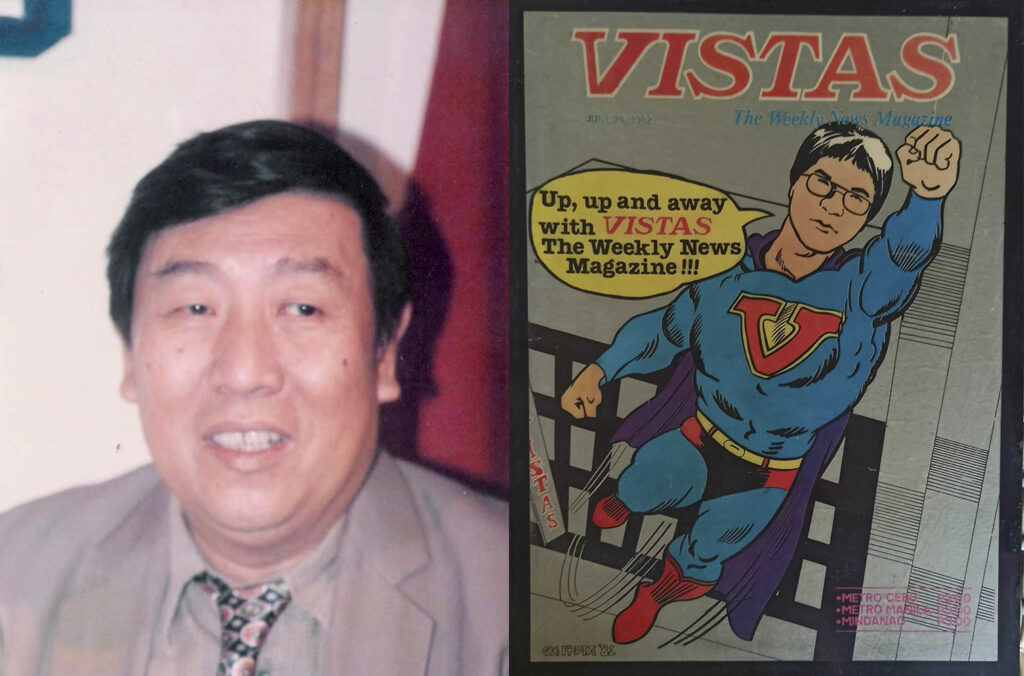
Jeruel Roa on Vistas weekly, its editor Jun Satorre and a bit about Jerry’s own journo stint.
(July 2023)
1. Vistas. Me and Pipet who wrote for the newsmagazine.
VISTAS Magazine was a weekly publication in Cebu between 1981 – 1984. My university classmate Perpeta Tandoc and I were the magazine’s staff writers. Our first editor was Jenara “Cookie” Regis Tobes (who years later became Mrs. Newman). Our general manager was Xavier C. Ledesma who was then the public relations man of San Miguel Corp. based in Cebu. Our stories were lifestyle, people, and events in the community.
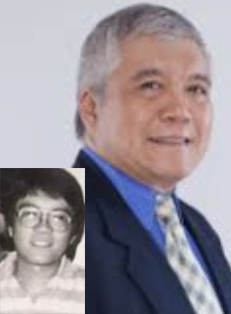
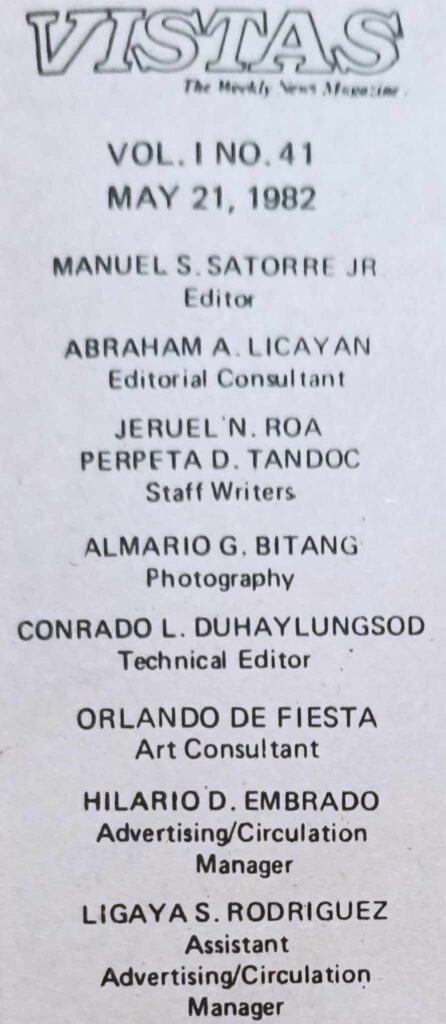
Jerry Roa: Satorre came and shifted the writers’ kind of writing in Vistas, from lifestyle and community stories to hard-news features. Roa’s profile on Jun Satorre came in some kind of spoof issue.
The format of the magazine shifted to news features. With the format change came a change in leadership with Atty. Manuel S. Satorre, Jr. taking the helm of both the editorial and management aspects of the business.
In both incarnations of the magazine, Atty. Satorre gave Pipet (now Atty. Tandoc) and I the opportunity to write about a wide variety of topics as possible. We broke gender biases as Pipet could ably dig into alleged anomalies in some government project while I could cover a beauty pageant.
Somehow, the sports beat was my constant. That’s where I found a mentor in Sun.Star’s sports editor Orlando C. Sanchez. (SunStar then had a dot between “Sun” and “Star,” Atty. Pachico A. Seares who created the brand name said, “for each to draw light and force from the other without fusing.” And sportswriter Sanchez then was better known as Orlacsan, a name that one of Mandaue City’s principal streets now bears.)
While covering sports, I was commissioned by San Miguel to be the “Sidelights” writer “color” reporter of events it sponsored like the Tour of Cebu cycling races and the National Football Championships held in Cebu.
Xavier Ledesma invited me to apply for an assistant’s position in the SMC Mandaue Public Relations office. When I joined San Miguel, doing Sidelights continued to be one of my “bread and butter plays” for events like the Coke Go for Goal (national youth football) championships and the Philippine Amateur Basketball League (PABL). By the time I was at San Miguel, Vistas had become a weekly supplement to Sun.Star Daily. 

Sketch by Orlando de Fiesta
2. Jun Satorre learned most journalism skills Cebu media industry offered, from cub reporting to editing, publishing
JERUEL N. ROA
(First published in Vistas June 26, 1982. Adapted by CJJ, updated by Jeruel Roa July 2023)
Manuel S. Satorre Jr. (1943-2023) was — successively but at times with one job overlapping another — proofreader then reporter, “Newsday”; contributor, “Morning Times”; correspondent for Philippine News Service; founder of a one-person local news agency, Cebu News & Information Service; reporter, DYHP-Channel 13, Channel 9, and DYRC; contributor, The Freeman; columnist, SunStar; editor, Vistas weekly newsmagazine; editor-business manager, Newstime Daily,
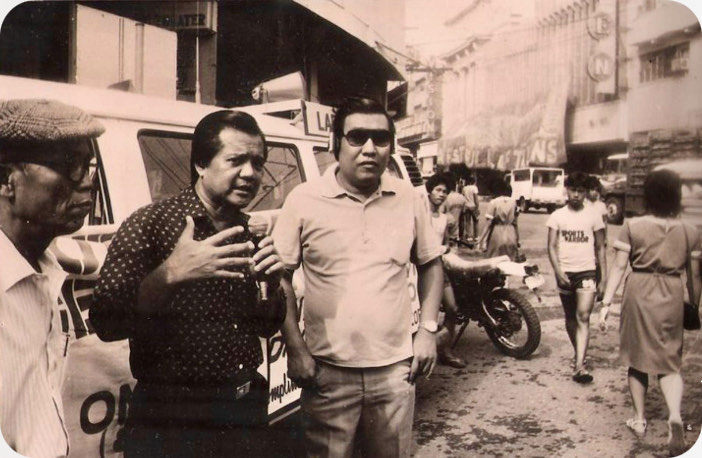
Jun Satorre (with dark glasses) joins an inspection visit by then Cebu City mayor Ronald R. Duterte. Duterte was city councilor 1963-1980, vice mayor 1980-1983 and mayor 1983-1986; he died at 71 in 2005. As a journalist, Satorre was able to watch, up close, public officials like Duterte. [From Satorre family files]
THE largely-built guy gets out of his light-blue Volkswagen (Beetle) with 999 plates and mis-aligned lights, huff-puffs his way through four flights of stairs, and by the time he reaches the office, rushes to his table, catches his breath, takes a long hard look at the sales chart, and asks for water.
One may think he’s a character out of Mario Puzo’s novels. Big belly, booming voice, black attache case and dark glasses.
But he smokes no cigars, only cigarettes, rarely trades his casual polo shirt for a suit, and speaks hardly any Italian except to quote some Latin phrases picked from his Law reference books.
His briefcase contains no contraband, no packets of dope or pornography. It is heavy with items to push – the latest issues of Vistas magazines which he promotes wherever he goes.
In his capacity as editor of Vistas The Weekly Newsmagazine, lawyer Manuel S. Satorre, Jr. does almost everything within legal means to promote the publication.
He produces the weekly with the least number of personnel possible to save on salary expenses. Even fan magazines employ batteries of writers but Vistas, he thinks, can do well with only himself, two writers and a photographer to run the editorial side of things. Worse, he thinks that he has Clark Kent and Lois Lane in his staff. And Peter Parker too, in lensman Almario Bitang.
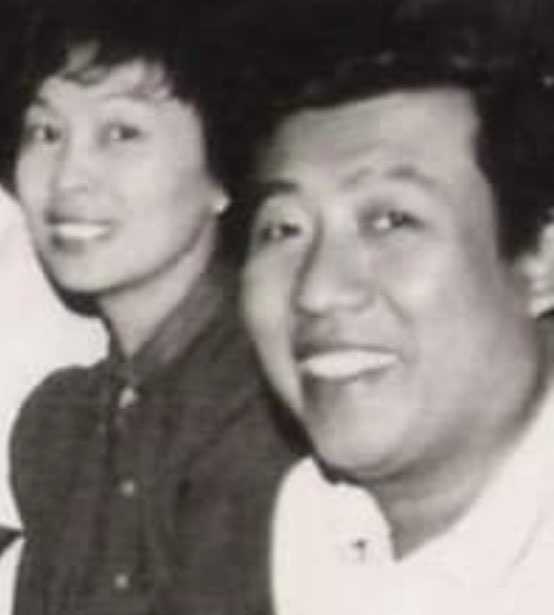
Jun Satorre, with wife Victoria Ang-Satorre, former dean of the University of San Carlos college of commerce. Their children are Jet, Jerome and Mark. [From Satorre family files]
Drive, energy
Jun, Maning, or Junior, whichever way you may call him, has amazing energy and drive for somebody his size. And it seems he requires that all the members of his team have the same level of energy and drive as well. He is married and one suspects he is the same whirlwind of a force at home.
He’s the kind of guy who can make you submit four magazine articles in one day, act as your alarm clock in the morning, and send you on the 11 th hour to another province for a coverage just as you were ready to embark on a three-day weekend.
He’s the one who’ll not let an opportunity go to waste and will make you interview VIPs at the shortest notice because they happen to be at the same coffee shop or airport departure area as you are at the moment. He’ll let you stack up on interviews that will leave you wondering what to do with 12 hours of un-transcribed tapes, and let you momentarily drop partly-finished works in progress for a new assignment.
In selecting materials for the week, he changes his mind as fast as he consumes his Marlboros. What was cover material two days ago could suddenly be relocated to the People section, while what was once a priority feature story may have to wait for another week.
Working ‘like a horse’
He keeps you busy, seven days a week, that before you know it you have started to grow a paunch from the lack of exercise and the excess of cocktails, lunches, and dinners. You’ve always wanted to enroll in a
progressive resistance training (PRT) class but the thought of him calling you up for an on-the-spot coverage while you’re lifting weights, makes you just forget about your fitness plan.
He’ll really make you work hard, “like a horse,” in his own words. But the guy knows his business. With long years of journalistic experience behind him, he can very well come up with the content of a magazine issue all by himself.
Satorre began his career in journalism as a 16-year-old proofreader of the Cebu daily tabloid “Newsday” in the early ‘60s. He also became a cub reporter under “Newsday” editor Hilario D. Embrado who taught him the rudiments of journalism. Embrado is Vistas’s advertising and circulation manager.
According to Satorre, Embrado assigned him the sensitive beats such as the Bureau of Customs, Bureau of Commerce, Bureau of Internal Revenue, City Hall, and the police.
After a brief stint with “Newsday,” he wrote articles for the “Morning Times,” a newspaper “almost everybody in Cebu media had worked for or with” at the time.
Didn’t outlast martial law
As he began to polish his skills in journalism, Satorre was taken as a correspondent of the Philippine News Service (PNS) then headed by Baldomero “Toto” Olivera.
“I worked in PNS as its youngest correspondent in the entire country,” Satorre said. He was with PNS until it was shut down, along with other media outfits, by Martial Law in September 1972. The PNS was headed by Oscar Rojo when it ceased operations.
Sometime in 1967, Satorre published and edited his own magazine, View, which was “of general circulation.”.
At the same time, he organized the first Cebu-based news agency which he called the Cebu News and Information Service (CNIS).
“Both investments lasted until Martial Law when they had to be closed down. They were never revived,” Satorre said.
Stints with broadcast
Briefly in the ‘60s, Satorre had stints in radio and television when he worked as news reporter with Radio Mindanao Network (RMN), which was then operating DYHP, a news and music station, and Channel 13.
“I was there as one of the news editors,” he said. “With me were now Channel 9’s Francisco Abao, Jr., Visayan Herald’s Danny Gonzales, the late Balt V. Quinain, and such personalities as Gem Alvez, Nash Alino, Gene Aranas, Ricky Torres, and Sammy Darza.”
“I was then a lone Balita-Patrol, the first in Cebu,” he continued. “As early as seven o’clock in the morning, I would be carrying my Grundig tape recorder and ride in the DYHP Kombi with an SSB. First stop was always the old Lahug Airport to be able to interview visiting dignitaries or those who merely stopped over. Then I toured the entire city for the different beats. At 12 o’clock noon, I started deskwork which lasted until three in the afternoon for DYHP’s every-hour, on-the-hour newscasts.”
After working with RMN, Satorre worked as news writer for radio and television stations such as Channel 3, then run by Henry Halasan, and DYRC.
Active in press clubs
Sometime in the late ‘60s, Satorre got involved in press club activities: he was elected a director of the splinter group of Federation of National Press Clubs. At the same time, he wrote regular features and sometimes covered events for The Freeman when it was still a weekly newsmagazine.
In 1971 he was elected president of the prestigious Association of Cebu Journalists (ACJ). “My term was an active one for the association. We had monthly fellowship meetings with regular guests. One of them was no other than Sen. Ninoy Aquino,” Satorre said.

Jun Satorre (right) in one of the conferences the journalist-lawyer attended abroad. [From Satorre family files]
In the same year, he was among the Philippine representatives in the U.S. Army-Pacific Philippine Friendship Mission to Hawaii. In 1972, he headed a four-person media delegation that visited Taiwan. The others In the group were Jose “Joe” Logarta of Republic News; Jess Vestil, then Channel 3 manager; and Louie Batongmalaque, station DYHP-Channel 13 manager.
While busy with media work, Atty. Satorre was also active in his law practice. But all of this came to a halt and he had to stop working for more than a year. “I began to have health problems, having put on weight with my blood pressure rising,” he said. The break did him good but “I had to return to action.”
In late 1973, Ronnie Tiangco and Joe Pavia — then managing editor and manager, respectively, of Philippine News Agency (PNA) which took over the PNS — asked Satorre to join PNA as a stringer. “ I was back to work,” he said.
Set up, didn’t lead PNA bureau
In 1974, he was asked to organize the PNA Cebu bureau, with himself as officer-in-charge. He recruited Henry Redula, the late Joe Martinez, Elma Abellanosa-Cartilla, and Manuel Oyson Jr. to join the agency.
Satorre did not have any plan to head the PNA as Cebu bureau manager; it was Redula who took the helm. Jun stayed on at PNA as stringer.
He was active in the Cebu News Correspondents Club, Inc., then headed by Abraham Licayan of the “Times Journal,” later by Hilario Embrado of “Bulletin Today.”
In 1980, Satorre was involved in organizing a weekly magazine which eventually became Vistas.
“At first, it was supposed to be named Weekly Views.” But because of some problems, I gave up the project although the magazine was pursued under the name Vistas, which operated for about nine months. When the magazine encountered format and financial problems, I was asked by the organizer to take over. That’s why I’m now here,” he said.
People swear that working with him is like going through a rigid test, where one has to perform a lot more and a lot better because of the energy and pace Satorre sets himself and his team. 
